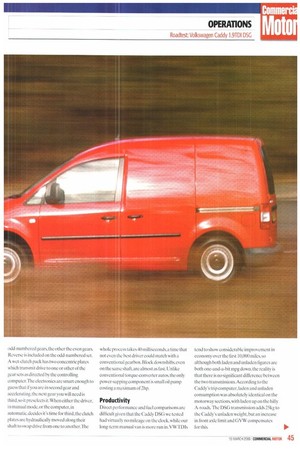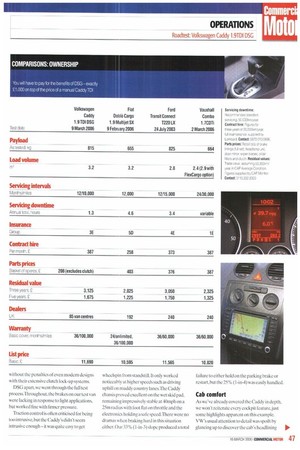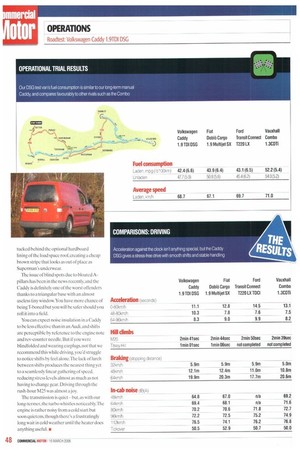AS EASY AS DSG
Page 44

Page 45

Page 46

Page 47

Page 48

If you've noticed an error in this article please click here to report it so we can fix it.
if you're following our long-term test, you'll know that CM has been impressed by WV's Caddy TD1. So how about a Caddy with all the benefits of a hassle-free Direct Shift Gearbox?
111 1 e make no apologies for this week's roadtest taking a slightly different format to usual. Although we will be looking at the whole vehicle, it is to one particular component that we direct most of our aftention.This is because the component represents the first major departure from conventional thinking in its field for half a century — and should it turn out to fulfil its potential, we wouldn't want to be seen in years to come as not having recognised it.
The vehicle is the Volkswagen Caddy TDI, increasingly familiar not just on the roads but also in these pages—it forms part of our current long-term test fleet.And the component is its DSG transmission, now available in a separate model priced £1 ,000 over the manual TOL DSG stands for Direct Shift Gearbox and was first seen on the road hack in 2003 in the AudiTT sports car, although its principles are an important part of Audi's Le Mans-type sports racing cars.
Initially sold on the strength of its sporting abilities, DSG has since become an integral part of the Volkswagen Group's staple car range —appearing on Seats and Skodas as well as behind VW and Audi badges,with production running at 1,000 units per day.At this point we should declare an interest, having owned a DSG-equipped car for 18 months.
Its appearance in the Caddy represents the final crossover from the sporting and luxury world to commercial vehicle operation. In both cases, the claimed benefits are the same — combining an automatic's ease of use with a manual's efficiency.
As we've frequently pointed out in our heavy truck tests, the greatest demand for automated transmissions basso far come from the premium long-distance tractors that probably need it least.There has been less penetration into the market sector that would really benefit: urban operations.
In the world of vans, automated transmissions have been most prevalent at 3.5 tonnes, without achieving overwhelming success. Ford has dropped the option on the next Transit, and Mercedes has ditched Sprintshift in favour of a fully-automatic torque-converter box which, thanks to the huge manufacturing output needed for its car ranges, M-B can do significantly cheaper than most.
Apart from VW. which just brought in Sprintmatic on the new Crafter, that leaves the Vauxhall/Renault/Nissan triumvirate with its TecShift system, and Iveco with its Agile automated manual. Except for the small-scale off-line conversion on the Citroen Berlingo a few years back, which failed to storm the market, it's hard to think of another car-sized van with self-changing gears this side of the Daf Variomatic or the Smiths Easidrive.
The DSG incorporates two separate gear trains, arranged in parallel.One provides the
odd-numbered gears, the other the even gears. Reverse is included on the odd-numbered set. A wet-clutch pack has two concentric plates which transmit drive to one or other of the gear sets as directed by the controlling computer.The electronics are smart enough to guess that if you are in second gear and accelerating, the next gear you will need is third,so it preselects it.When either the driver, in manual mode, or the computer, in automatic, decides it's time for third, the clutch plates are hydraulically moved along their shaft to swap drive from one to another.The whole process takes 40 milliseconds, a time that not even the hest driver could match with a conventional gearbox. Block downshifts, even on the same shaft, are almost as fast. Unlike conventional torque-converter autos, the only power-sapping component is small oil pump costing a maximum of 2hp.
Productivity
Direct performance and fuel comparisons are difficult given that the Caddy DSG we tested had virtually no mileage on the clock, while our long-ten-n manual van is more run in. VW TD1s
tend to show considerable improvement in economy over the first 10,000 miles, so although both laden and unladen figures are both one-and-a-bit mpg down, the reality is that there is no significant difference between the two transmissions. According to the Caddy's trip computer, Laden and unladen consumption was absolutely identical on the motorway sections, with laden up on the hilly A-roads. The DSG transmission adds 25kg to the Caddy's unladen weight,but an increase in front axle limit and GVW compensates for this,
On the road
From the driver's viewpoint, the big difference is obviously the lack of a clutch pedal and conventional manual gear stick. Instead, t he Caddy has a normal automatic-type quadrant, with a silver-finish surround and a big chrome interlock button. From front to rear, the gear positions are marked P-R-N-D-S. In D, there is an alternative position to the left which provides the manual change, forward for up and back for down. Unlike cars with DSG, there are no steering-wheel-mounted paddles or Tipmatic buttons. You do get the uprated midline driver information panel, which displays: the time:a two-channel trip computer. including time and distance run; instant and average fuel consumption; average speed and fuel range: outside temperature with audible warning: and a repeater graphic for sat nay (if fitted) all controlled by the right-hand column stalk. Beneath the trip computer is the gear display pan el.This shows the mode selected and, in the bottom-right corner, which gear is currently engaged in automatic mode. Change to manual mode and P-R-N-D-S becomes 6-5-4-3-2-1.
The safety interlock needs the footbrake to be pressed to avoid unintentionally selecting first or reverse from park or neutral. Moving off is the same as any auto: select D and press the throttle. Floor the pedal and it will give maximum revs. For more normal driving, a light throttle will produce upshifts at around 2,500rpm keeping the engine in its most efficient range as far as possible. Simply by modifying the throttle opening, it's possible to produce upshifts or downshifts on demand. The S position increases the engine speed of upshifts to the point that it is normally one ratio higher than in D. At low speeds, fine control of the transmission is available just on the throttle pedal. though very slow manoeuvring uphill in reverse needs a delicate touch. By the way, the Caddy's reversing lights are exceptionally bright.
Using S for standing-start acceleration has surprisingly little effect, but greater benefits are apparent on the rolling acceleration runs: S knocked off about 0.3 seconds on both 30-50 and 40-60mph tests. Despite the other-shaft pre-selection design. there is no perceptible delay while the box kicks down from. say, fifth to third compared with from fifth to fourth.
Apart from the initial novelty, there will be few reasons to use manual mode, other than to provide engine braking on descents or for greater control in poor conditions. If you leave the Caddy in manual and accelerate far beyond its parameters, the DSG will take over if you want to hang on for whatever reason, you will soon learn how far to take it. Li kewise, if the van comes to rest it will revert to first gear. Are there any downsides? Not many demand for power from stationary or at walking pace secs a brief but noticeable delay, although probably less than the time it would take to release the clutch to engage manual drive. It just seems longer when you're waiting with nothing to do.There is also some creep at tickover.although pressing the footbrake does disengage the drive.
The DSG is probably even better suited to the 103hp TM's flatter torque curve than to the 140 engines. In the 140, until you get accustomed to it, it's easy to believe that nothing's happening during that brief delay so you press harder, then drive takes up just in time for the greater amount of torque to hurl you forward in a rather disconcerting manner. Although acceleration against the clock doesn't look anything special, the speed off the line in real world is sufficient to need lobe wary of not taking others by surprise.The shift is as smooth as any torque-converter box but without the penalties of even modern designs with their extensive clutch lock-up systems.
DSG apart, we went through the full test process.Throughout, the brakes on our test van were lacking in response to light applications, but worked fine with firmer pressure.
Traction control is often criticised for being too intrusive, but the Caddy's didn't seem intrusive enough -it was quite easy to get wheelspin from standstill. It only worked noticeably at higher speeds such as driving uphill on muddy country lanes.The Caddy chassis proved excellent on the wet skid pad, remaining impressively stable at 40mph on a 25m radius with foot flat on throttle and the electronics holding a safe speed:There were no dramas when braking hard in this situation either. Our 33% (1-in-3) slope produced a total failure to either hold on the parking brake or restart, but the 25% (1-in-4) was easily handled.
Cab comfort
As we've already covered the Caddy in depth, we won't reiterate every cockpit feature,just some highlights apparent on this example. VW's usual attention to detail was spoilt by glancing up to discover the cab's headlining tucked behind the optional hardboard lining of the load space roof, creating a cheap brown stripe that looks as out of place as Superman's underwear.
The issue of blind spots due to bloated Apillars has been in the news recently. and the Caddy is definitely one of the worst offenders thanks to a triangular base with an almost useless tiny window.You have more chance of beingT-boned but you will he safer should you roll it into a field.
You can expect noise insulation in a Caddy to be less effective than in an Audi, and shifts are perceptible by reference to the engine note and rev-counter needle. But if you were blindfolded and wearing earplugs, not that we recommend this while driving. you'd struggle to notice shifts by feel alone.The lack of lurch between shifts produces the nearest thing yet to a seamlessly linear gathering of speed, reducing stress levels almost as much as not having to change gear. Driving through the rush-hour M25 was almost a joy.
The transmission is quiet but, as with our long-termer, the turbo whistles noticeablyThe engine is rather noisy from a cold start but soon quietens, though there's a frustratingly long wait in cold weather until the heater does anything useful. •
































































































































































































